What Is a Market Portfolio?
A market portfolio refers to a theoretical or actual portfolio that includes all available investment assets in the market.
The market portfolio aims to capture the overall performance of the entire market rather than focusing on specific sectors or individual securities.
It serves as a benchmark for measuring the performance of other portfolios and investment strategies.
The concept of a market portfolio is closely associated with the Capital Asset Pricing Model (CAPM), which suggests that the market portfolio is the optimal portfolio for all investors in terms of risk and return.
However, constructing a true market portfolio is challenging in practice, so market indices such as the S&P 500 or the Dow Jones Industrial Average are often used as proxies for the market portfolio.
Understanding the Market Portfolio Theory
Capital Market Line (CML)
The Capital Market Line is a graphical representation of the risk and return trade-off for efficient portfolios, with risk measured as the standard deviation of the portfolio's return.
The CML originates from the risk-free rate and is tangent to the efficient frontier at the market portfolio. The slope of the CML represents the market price of risk, and any point along the CML indicates a combination of the risk-free asset and the market portfolio.
Capital Asset Pricing Model (CAPM)
The Capital Asset Pricing Model, a byproduct of the MPT, is a model that describes the relationship between systematic risk and expected return for assets, particularly stocks.
The CAPM asserts that the expected return of a security or a portfolio equals the rate on a risk-free security plus a risk premium. This risk premium is based on the beta of the security or portfolio, which measures its sensitivity to market movements.
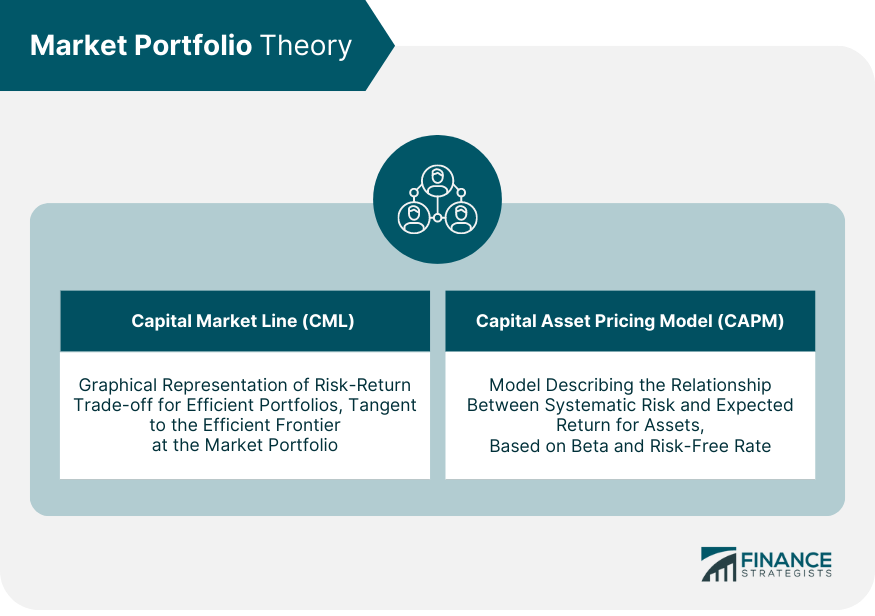
Risk and Return in Market Portfolio
The market portfolio, by its nature, carries the average risk of all investable assets in the market. The expected return of the market portfolio is equal to the average return of all the assets in the market, weighted by their market values.
It's important to note that the market portfolio is on the efficient frontier, meaning it offers the highest possible expected return for a given level of risk.
This is based on the assumption that markets are efficient and that all relevant information is fully and immediately reflected in market prices.
Different Asset Classes in a Market Portfolio
Equities
Equities represent ownership in a company and constitute a significant portion of the market portfolio. They offer potentially high returns but carry a higher risk compared to other asset classes.
Bonds
Bonds are debt securities issued by governments, municipalities, and corporations. They pay interest over a specific period and return the principal upon maturity. Bonds provide regular income and are generally considered lower risk than equities.
Cash and Cash Equivalents
These are the most liquid assets, including physical cash, money market instruments, and short-term government securities. They offer stability and liquidity but yield lower returns.
Real Estate
Real estate includes residential, commercial, and industrial properties. Real estate investments can provide rental income and potential appreciation.
Commodities
Commodities include physical assets like gold, oil, natural gas, agricultural products, and more. They serve as a hedge against inflation and provide portfolio diversification.
Alternative Investments
This category includes hedge funds, private equity, venture capital, collectibles, and more. They are less correlated with traditional asset classes, providing additional diversification and potentially high returns, but often come with higher risk and lower liquidity.
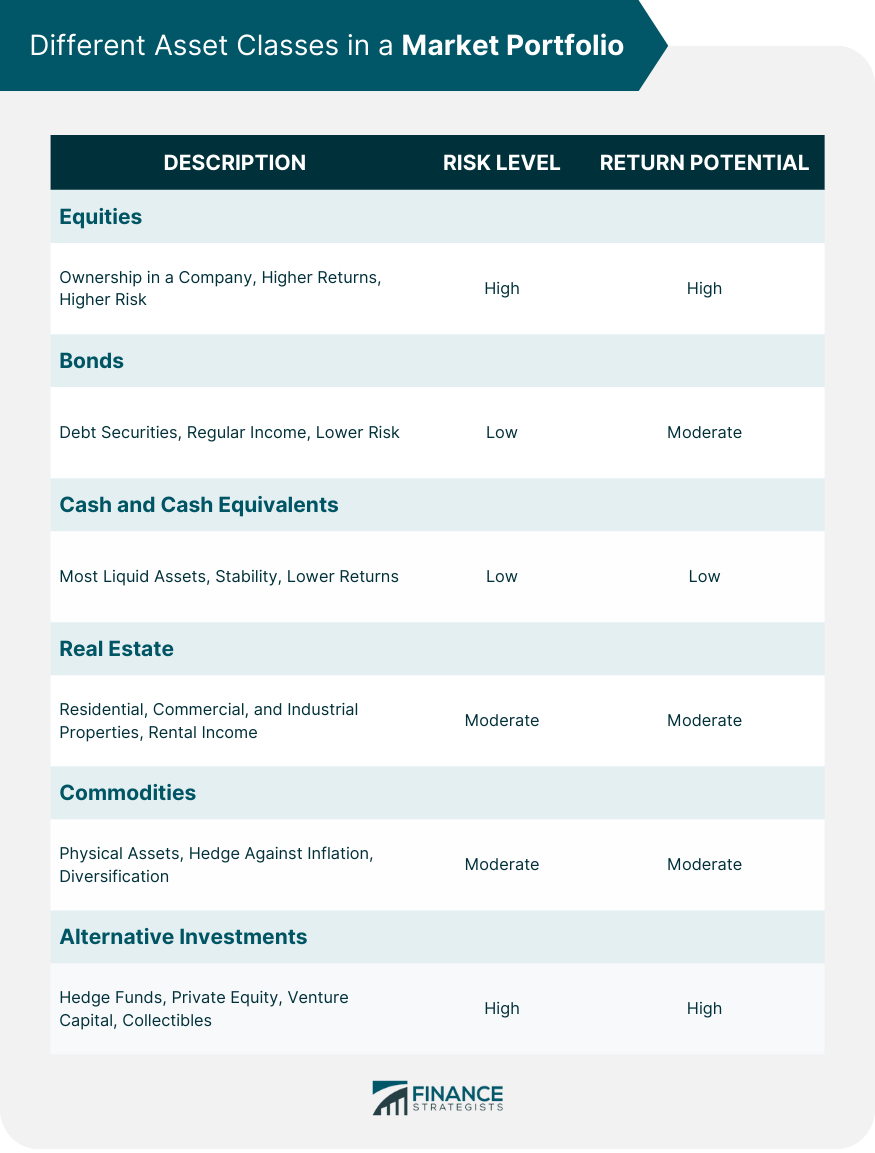
Building a Market Portfolio
Assessing Risk Tolerance
The first step in building a market portfolio is understanding your risk tolerance. This is a measure of your willingness and ability to take on risk in your investment portfolio.
Factors influencing risk tolerance include your financial goals, investment horizon, financial capacity, and emotional comfort with risk.
Diversification and Its Importance
Diversification is the practice of spreading investments across various assets or asset classes to reduce risk. The idea is that a decline in one investment may be offset by the performance of others.
In a market portfolio, diversification is inherently achieved due to the broad inclusion of all investable assets.
Asset Allocation Strategies
Asset allocation is the process of dividing a portfolio among different asset classes based on an investor's financial goals, risk tolerance, and investment horizon. There are various strategies for asset allocation, including strategic, tactical, and dynamic.
Strategic asset allocation involves setting target allocations for various asset classes and periodically rebalancing the portfolio back to these targets.
Tactical asset allocation allows for a range of percentages in each asset class and periodically rebalancing the portfolio when it deviates from the initial asset mix.
Dynamic asset allocation involves constant adjustments of the proportions of assets in the portfolio based on market conditions or economic indicators.
Portfolio Rebalancing Techniques
Portfolio rebalancing is the act of adjusting the proportions of assets in a portfolio to maintain a desired level of risk and return. It involves selling assets that have increased in value and buying those that have decreased in value.
Rebalancing can be done on a time-only basis, a threshold-only basis, or a combination of both. It's crucial in maintaining the diversification of a market portfolio and managing risk over time.
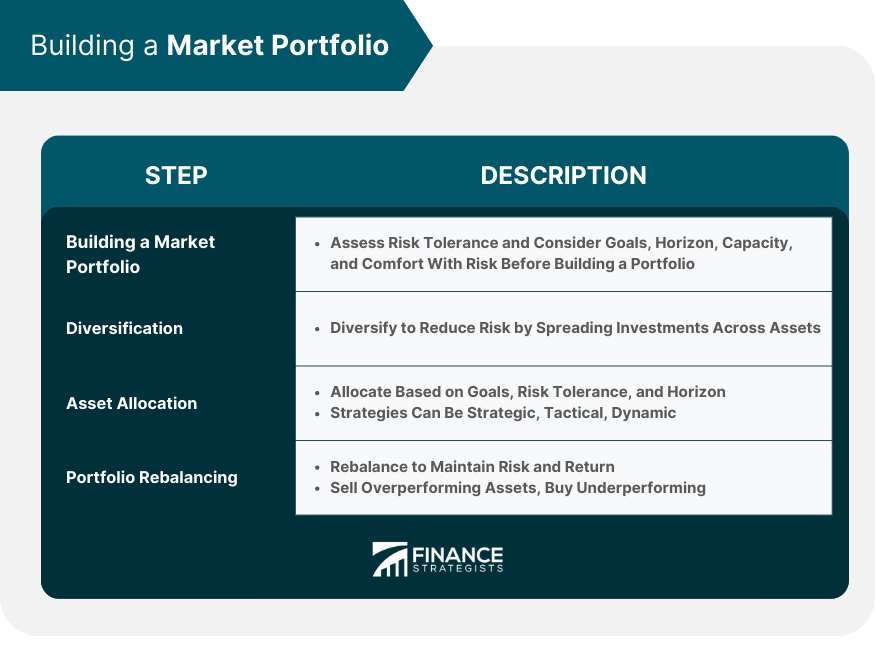
Performance Evaluation of a Market Portfolio
Benchmarking and Its Importance
Benchmarking involves comparing a portfolio's performance against a standard or a set of standards. For a market portfolio, the benchmark is typically a broad market index like the S&P 500 or MSCI World Index.
The purpose of benchmarking is to evaluate how well a portfolio is doing relative to the market or its peers.
Use of Performance Metrics
Evaluating the performance of a market portfolio involves using specific metrics that measure both risk and return. Three commonly used metrics are:
Sharpe Ratio
The Sharpe Ratio measures the performance of an investment compared to a risk-free asset after adjusting for its risk. It's a measure of risk-adjusted return, with a higher Sharpe ratio indicating a better reward per unit of risk taken.
Sortino Ratio
The Sortino Ratio is similar to the Sharpe Ratio but only considers downside risk or negative volatility. It provides a better view of the portfolio's risk-adjusted return when returns are not normally distributed or when downside fluctuations are of more concern.
Treynor Ratio
The Treynor Ratio measures the returns earned above the risk-free rate per each unit of market risk. Unlike Sharpe and Sortino Ratios, which use total risk, the Treynor Ratio uses systematic risk, making it more suitable for well-diversified portfolios like the market portfolio.
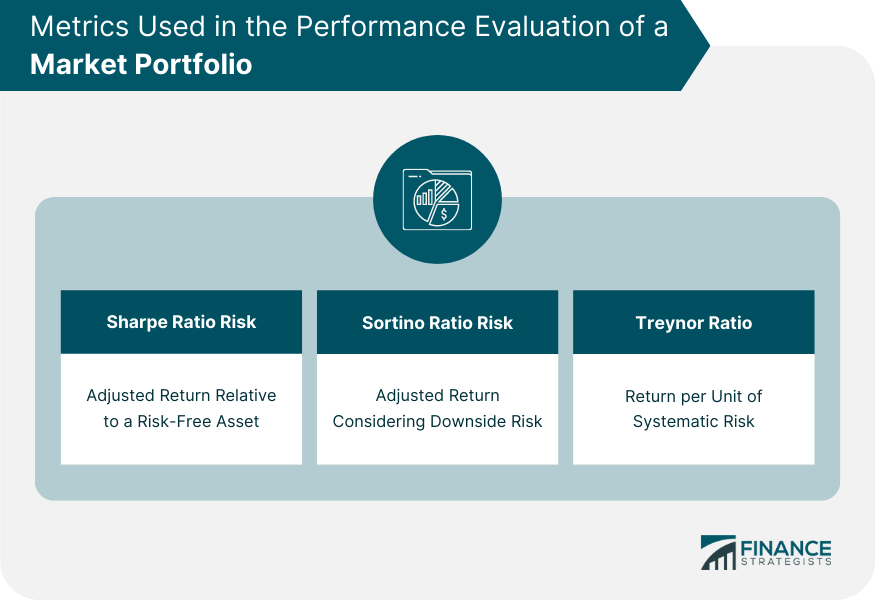
Impact of Market Conditions on Portfolio Performance
Market conditions can significantly impact the performance of a market portfolio.
Factors such as interest rates, inflation, geopolitical events, economic indicators, and technological changes can all affect the prices of assets in the portfolio. Monitoring these factors and understanding their potential impact is crucial in managing a market portfolio.
Criticisms and Limitations of the Market Portfolio Approach
Assumptions in the Market Portfolio Theory
The market portfolio theory is based on several assumptions, such as investors being rational and markets being efficient, which may not hold in real-world situations.
For example, investors may be driven by emotions and cognitive biases, and markets may not always fully and immediately reflect all available information.
Challenges in Achieving True Diversification
While the market portfolio is theoretically fully diversified, achieving true diversification in practice can be challenging.
Some asset classes may be inaccessible or prohibitively expensive for individual investors, and the correlations between assets can change over time, affecting the portfolio's risk and return characteristics.
Impact of Market Inefficiencies
Market inefficiencies, such as price distortions due to behavioral biases or limits to arbitrage, can lead to deviations from the expected risk and return of the market portfolio.
Also, factors like transaction costs, taxes, and regulations can impact the implementation and performance of a market portfolio.
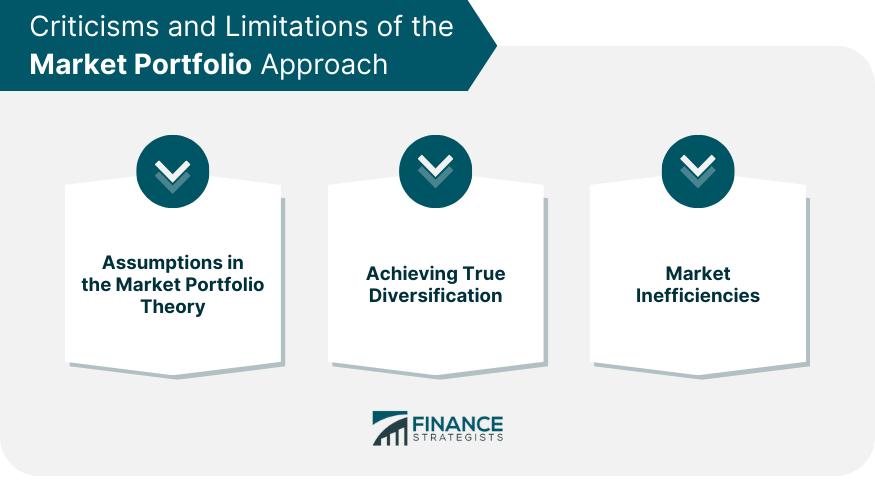
Final Thoughts
The market portfolio is a theoretical or actual portfolio that aims to capture the overall performance of the entire market.
It serves as a benchmark for evaluating other portfolios and investment strategies. The Capital Asset Pricing Model (CAPM) and the Capital Market Line (CML) are key concepts associated with the market portfolio theory, providing insights into risk and return trade-offs.
The market portfolio carries the average risk of all investable assets in the market and is positioned on the efficient frontier, offering the highest expected return for a given level of risk.
Different asset classes, such as equities, bonds, cash, real estate, commodities, and alternative investments, contribute to the composition of a market portfolio, each with its own risk and return potential.
Building a market portfolio involves assessing risk tolerance, diversification, asset allocation strategies, and portfolio rebalancing techniques.
Performance evaluation of a market portfolio requires benchmarking against market indices and using metrics like the Sharpe Ratio, Sortino Ratio, and Treynor Ratio.
However, the market portfolio approach also has limitations, including assumptions in market portfolio theory, challenges in achieving true diversification, and the impact of market inefficiencies.
Market Portfolio FAQs
A market portfolio is a theoretical bundle of investments that includes every type of investable asset in the market, each one proportionally represented according to its market value.
A market portfolio, by definition, carries the average risk of all investable assets in the market. It offers the highest possible expected return for a given level of risk, assuming markets are efficient.
The key components of a market portfolio include various asset classes such as equities, bonds, cash and cash equivalents, real estate, commodities, and alternative investments.
Performance evaluation of a market portfolio involves benchmarking against a broad market index and using performance metrics like Sharpe Ratio, Sortino Ratio, and Treynor Ratio that measure risk-adjusted returns.
The limitations of the market portfolio approach include assumptions in the market portfolio theory, challenges in achieving true diversification, and the impact of market inefficiencies.
True Tamplin is a published author, public speaker, CEO of UpDigital, and founder of Finance Strategists.
True is a Certified Educator in Personal Finance (CEPF®), author of The Handy Financial Ratios Guide, a member of the Society for Advancing Business Editing and Writing, contributes to his financial education site, Finance Strategists, and has spoken to various financial communities such as the CFA Institute, as well as university students like his Alma mater, Biola University, where he received a bachelor of science in business and data analytics.
To learn more about True, visit his personal website or view his author profiles on Amazon, Nasdaq and Forbes.











